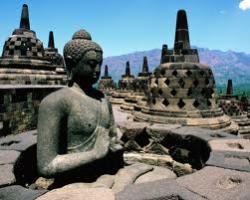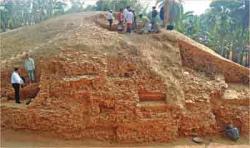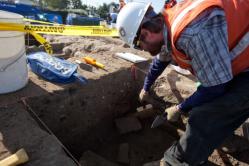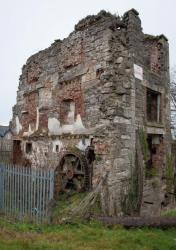03 FEVRIER
INSTITUT SUPERIEUR D’ANTHROPOLOGIE INDI-UNI :
INSCRIPTION 2012 / 2 COURS A DISTANCE
REGISTRATION 2012 /2 ONLINE COURSES
INDONESIE –  Borobudur - The Borobudur Temple Conservation Agency received an ancient relief stone found by a Mendalan villager in Magelang, yesterday. The square stone was allegedly part of the temple’s relief. “We’ll conduct further study,” said Yudi Suhartono, the documentation and publication group work’s coordinator, yesterday. The stone with the Buddha pattern from the VIII century will be matched with 9,000 stones at the Borobudur Museum that have not been assembled. “If it matches, we can assemble it,” said Yudi. The finding, which has not been assembled, included two artifact heads that were found by a Tanjungsari resident in 2010. The heads were part of the Borobudur Temple.
Borobudur - The Borobudur Temple Conservation Agency received an ancient relief stone found by a Mendalan villager in Magelang, yesterday. The square stone was allegedly part of the temple’s relief. “We’ll conduct further study,” said Yudi Suhartono, the documentation and publication group work’s coordinator, yesterday. The stone with the Buddha pattern from the VIII century will be matched with 9,000 stones at the Borobudur Museum that have not been assembled. “If it matches, we can assemble it,” said Yudi. The finding, which has not been assembled, included two artifact heads that were found by a Tanjungsari resident in 2010. The heads were part of the Borobudur Temple.
http://www.tempointeractive.com/hg/nasional/2012/01/26/brk,20120126-379856,uk.html
ROYAUME- UNI –  Londres - Crossrail has adopted a new approach to the restoration of the Connaught Tunnel under the Royal Docks which it says is safer and more efficient. There will also be a specialist search for unexploded bombs from the Second World War, while archaeologists are set to excavate the site to search for ancient settlements. Crossrail archaeologists will open excavation trenches to try to locate evidence of human settlement and farming in the area dating back nearly 6,000 years. Working with the Museum of London Archaeology, Crossrail also aims to map the effect of the River Thames on the area during historic and prehistoric times.
Londres - Crossrail has adopted a new approach to the restoration of the Connaught Tunnel under the Royal Docks which it says is safer and more efficient. There will also be a specialist search for unexploded bombs from the Second World War, while archaeologists are set to excavate the site to search for ancient settlements. Crossrail archaeologists will open excavation trenches to try to locate evidence of human settlement and farming in the area dating back nearly 6,000 years. Working with the Museum of London Archaeology, Crossrail also aims to map the effect of the River Thames on the area during historic and prehistoric times.
http://www.wharf.co.uk/2012/02/new-approach-to-docklands-tunn.html
INDE –  Mahasthangarh - Archaeologists have recently excavated different objects, including ornamental bricks, terracotta plaques, stone slabs, cells, terracotta balls, potshards, toy objects, brick tiles and iron artefacts, from Mahasthangarh in Bogra. The excavators claim the discovery will help one know more about the Gupta dynasty (320-550 AD) and Pal (7501174 AD) dynasty. “We have found hundreds of bricks of different periods, including the Gupta and Pal dynasties during the excavation,” said Md Badrul Alam, leader of the excavation team and director for Rajshahi region of the Department of Archaeology. A five-member team of the department began the excavation in Mahasthangarh's western part, known as 'Tamro Duar' on January 19 this year. Dr Md Shafiqul Alam, former director general of the department now working as a specialist with the team, said that a brick-built wall had been found that seemed to be a symbol of the Maurya dynasty. “Earlier we found five occupations levels of pre-Maurya dynasty," he said, adding, “So far we have found 16 habitat levels in the city and adjacent areas.” Md Abdul Khaleque, former director of the department of archaeology, Rajshahi region, who is also working as a specialist with the team, said a structure was found during the excavation this week. "The structure might have been used as a protection wall of the Tamro Duar (a gateway) during the Gupta dynasty. “More excavations are needed for additional information about the wall and artifacts," said Abdul Khaleque. “Since 1922, we have found various archaeological objects and structures of different dynasties, including the pre-Maurya dynasty, in several archaeological excavations," he added.
Mahasthangarh - Archaeologists have recently excavated different objects, including ornamental bricks, terracotta plaques, stone slabs, cells, terracotta balls, potshards, toy objects, brick tiles and iron artefacts, from Mahasthangarh in Bogra. The excavators claim the discovery will help one know more about the Gupta dynasty (320-550 AD) and Pal (7501174 AD) dynasty. “We have found hundreds of bricks of different periods, including the Gupta and Pal dynasties during the excavation,” said Md Badrul Alam, leader of the excavation team and director for Rajshahi region of the Department of Archaeology. A five-member team of the department began the excavation in Mahasthangarh's western part, known as 'Tamro Duar' on January 19 this year. Dr Md Shafiqul Alam, former director general of the department now working as a specialist with the team, said that a brick-built wall had been found that seemed to be a symbol of the Maurya dynasty. “Earlier we found five occupations levels of pre-Maurya dynasty," he said, adding, “So far we have found 16 habitat levels in the city and adjacent areas.” Md Abdul Khaleque, former director of the department of archaeology, Rajshahi region, who is also working as a specialist with the team, said a structure was found during the excavation this week. "The structure might have been used as a protection wall of the Tamro Duar (a gateway) during the Gupta dynasty. “More excavations are needed for additional information about the wall and artifacts," said Abdul Khaleque. “Since 1922, we have found various archaeological objects and structures of different dynasties, including the pre-Maurya dynasty, in several archaeological excavations," he added.
http://www.thedailystar.net/newDesign/news-details.php?nid=221011
USA –  Los Angeles - An excavation near the San Gabriel Mission has uncovered remnants of one of Los Angeles’ most important early cultural centers. Archaeologists began digging in November near the mission, where San Gabriel city officials are creating a subterranean path for freight and passenger trains. The legally mandated dig has unearthed the remnants of a mill dating back to the 18th century, as well as a group of other buildings.
Los Angeles - An excavation near the San Gabriel Mission has uncovered remnants of one of Los Angeles’ most important early cultural centers. Archaeologists began digging in November near the mission, where San Gabriel city officials are creating a subterranean path for freight and passenger trains. The legally mandated dig has unearthed the remnants of a mill dating back to the 18th century, as well as a group of other buildings.
VIDEO = http://www.youtube.com/watch?v=jnHBsnTYQ4Y
http://www.scpr.org/news/2012/02/02/31084/archaeologists-dig-san-gabriels-past-wake-construc/
ROYAUME UNI –  – Caledon - Restoration work has begun to save Caledon’s original archaeological treasures, including a housed beam engine, the only one still in existence in the British Isles. Large sums of government and private money is being poured into the village to restore parts of the Caledon Estate and relics of the village’s once thriving woolen industry. A team of architects and specialist builders have already begun work on restoring the mill’s beam house, a type of steam engine where a pivoted overhead beam is used to supplement the flow for a waterwheel mill. William Beattie of Caledon Regeneration Partnership said he believed the beam engine is unique in the British Isles. “There are only about eight beam engines in Ireland, and this one is the only one which has a housed engine, making it a very important piece of industrial archaeology”, he said. “This is the only relic remaining of Caledon’s once famous mill industry, which produced quality woolen garments until the 1930s. “The mill, which was built in the early 1800s, was demolished in 1985. During the summer, wood and coal was used to power the beam engine, when the water-flow was not strong enough to move the wheel.
– Caledon - Restoration work has begun to save Caledon’s original archaeological treasures, including a housed beam engine, the only one still in existence in the British Isles. Large sums of government and private money is being poured into the village to restore parts of the Caledon Estate and relics of the village’s once thriving woolen industry. A team of architects and specialist builders have already begun work on restoring the mill’s beam house, a type of steam engine where a pivoted overhead beam is used to supplement the flow for a waterwheel mill. William Beattie of Caledon Regeneration Partnership said he believed the beam engine is unique in the British Isles. “There are only about eight beam engines in Ireland, and this one is the only one which has a housed engine, making it a very important piece of industrial archaeology”, he said. “This is the only relic remaining of Caledon’s once famous mill industry, which produced quality woolen garments until the 1930s. “The mill, which was built in the early 1800s, was demolished in 1985. During the summer, wood and coal was used to power the beam engine, when the water-flow was not strong enough to move the wheel.
http://www.tyronetimes.co.uk/news/local/caledon_s_unique_archaeological_treasures_to_be_resurrected_1_3484104
ROYAUME UNI – North Pennines - More digs are being planned in one of the North East’s top landscape areas after the success of a community archaeology project. Highlights of the pilot phase last year included excavations at Westgate Castle in Weardale, a survey of the archaeological landscape of Holwick in Upper Teesdale, the survey and excavation at Muggleswick Grange near Castleside in County Durham and the excavation of the Maiden Way Roman road near Alston in Cumbria. Current fieldwork proposals include surveys and excavations to investigate: * The first people who lived in the North Pennines after the end of the Ice Age 10,000 years ago. * The first farmers of about 6,000 years ago. * Relations between Romans and native communities from the First to the early Fifth Centuries. * The mysterious centuries after the end of Roman rule and before the Norman Conquest of 1066. * The great hunting forests and deer parks of medieval times. * The origins and history of the North Pennines lead industry.
http://www.journallive.co.uk/north-east-news/environment-news/2012/02/03/community-archaeology-project-success-leads-to-more-north-east-digs-61634-30256658/
KENYA – Mombasa - Just before the Portuguese surrendered to the Arabs in 1697, there was an intense battle for control of Fort Jesus. In the process, a Portuguese warship that had been deployed near the fort was sunk. Christened Santo Antonio, the ship still lies on the sea bed near the fort, piling on rust by the kilo. But Santo Antonio's fate could soon change because the National Museums of Kenya (NMK) is planning to salvage it and turn it into a tourist attraction. Industry players say there is a fortune lying deep in the waters that surround Mombasa, one of the most important trade and military destinations of the 17th century. Because of its role as a convergence point for Portuguese, Arab, and British explorers, the port town witnessed some of the bloodiest conflicts during that era, and NMK believes that there are tens of ships wrecked around the island. Underwater archaeologists say that, if well preserved, these shipwrecks and the artefacts they are believed to hold could help revive cultural tourism at the Coast, a sector whose fortunes have dwindled over the past few years. There are many other ships that sank off Mombasa, including Highland Lassie (1879), Sussex (1909), and Hamad (1909). Of the 32 known shipwrecks along the Kenyan coastline, 11 have lain in the deep waters for more than 50 years. The rest have been there for a shorter period.
http://allafrica.com/stories/201202030003.html